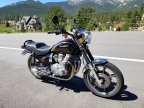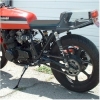1982 kz1100 a2
- rl1062
-
Topic Author
- Offline
- User
-

Registered
- Posts: 5
- Thanks: 0
1982 kz1100 a2
02 May 2017 06:55
I am trying to finish up an old shaftie and am having a problem with lights - i dont have any. no brakes or turn signals. I have found what is listed as a diode os the wiring diagram located under the seat that connects to all affected items and meter shows resistance. It is an old mitsubishi part sr3am-8 17. I am looking for a current item to sub in
Please Log in or Create an account to join the conversation.
- rl1062
-
Topic Author
- Offline
- User
-

Registered
- Posts: 5
- Thanks: 0
Re: 1982 kz1100 a2
04 May 2017 11:58 - 04 May 2017 11:59Attachments:
Last edit: 04 May 2017 11:59 by rl1062.
Please Log in or Create an account to join the conversation.
- ajsfirehawk
-

- Offline
- Sustaining Member
-

Registered
- Posts: 513
- Thanks: 90
Re: 1982 kz1100 a2
04 May 2017 20:08
It has resistance in the direction the current is supposed to flow? It the diode the point where you lose the 13V?
80 KZ1000 Z1 Classic
83 KZ1100 LTD
18 Z900RS
23 Mach 1
83 KZ1100 LTD
18 Z900RS
23 Mach 1
Please Log in or Create an account to join the conversation.
- daveo
-

- Offline
- Premium Member
-

Registered
- Posts: 2953
- Thanks: 763
Re: 1982 kz1100 a2
04 May 2017 22:04 - 04 May 2017 22:08
What is the purpose of this part?
21066-026 is referred to as a REGULATOR in the CMS parts list. :S
www.cmsnl.com/kawasaki-kz1100a2-shaft-19...066026/#.WQwGgbhqCt8
21066-026 is referred to as a REGULATOR in the CMS parts list. :S
www.cmsnl.com/kawasaki-kz1100a2-shaft-19...066026/#.WQwGgbhqCt8
1982 KZ1100-A2
Last edit: 04 May 2017 22:08 by daveo.
Please Log in or Create an account to join the conversation.
- Scirocco
-

- Offline
- Premium Member
-

Registered
- Never change a running system
- Posts: 4420
- Thanks: 2269
Re: 1982 kz1100 a2
04 May 2017 23:46 - 04 May 2017 23:49
It is a diode not a regulator.
The electric current flows only in the direction of the silver ring marking on the diode.
It looks like someone soldered it up side down,so the current can not flow in the right direction.
Michael
The electric current flows only in the direction of the silver ring marking on the diode.
It looks like someone soldered it up side down,so the current can not flow in the right direction.
Michael
My 1975 Z 1 B 900 Project
www.kzrider.com/forum/11-projects/605133...ears-deep-sleep-mode
www.kzrider.com/forum/11-projects/605133...ears-deep-sleep-mode
Last edit: 04 May 2017 23:49 by Scirocco.
The following user(s) said Thank You: GPz550D1, daveo
Please Log in or Create an account to join the conversation.
- loudhvx
-

- Offline
- KZr Legend
-

Registered
- Posts: 10864
- Thanks: 1619
Re: 1982 kz1100 a2
05 May 2017 06:59 - 05 May 2017 10:33
I don't have an 82 1100 A diagram, but I'm using an 82 1100 D diagram. It also shows the diode.
In this case, the diode is there as a stop-gap measure to make up for the ignition switch's lack of a dedicated tail light contact during normal operation.
In the "park" position of the ignition switch, the main fuse power is routed directly to the red wire to the tail light.
In the "run" position of the ignition switch, the main fuse power is routed back to the fuse box to power several different fuses to power the bike. In this mode, the tail light gets its power through the secondary lighting fuse. (That powers the marker lights and gauge lights etc.)
The problem with this setup is that when the ignition switch is set to "park", which powers the tail light, it would also end up powering the whole bike. The power going to the tail light would back feed current to the other lights, and through the secondary lighting fuse, would end up powering the entire bike.
To prevent this back-feed of power, they put a diode in the line between the secondary lighting circuit and the tail light. This way current could only go toward tail light from the secondary lighting system, but not the other way.
Basically the diode lets the secondary lighting circuit power the tail light, but prevents the tail light from powering the secondary lighting circuit when the switch is in "park" position.
Othe KZ's solve this problem by using a more sophisticated ignition switch with more contacts where the tail light gets its own dedicated circuit.
You have a few options:
1) Replace the diode. It looks to be a 3 to 5 amp diode. I would err on the high side and get a standard 5-amp diode. It should have a peak-inverse-voltage (PIV) rating of about 50v or higher. This is sometimes called peak-reverse-voltage (PRV). Radio Shack used to carry them. Sometimes diodes are called "rectifiers". That is the type of diode you want. Silicon rectifying diode. The original may have been selenium or there is a slight chance it may have been germaium. Those types are more efficient (by wasting less power they make the tail light slightly brighter), but they are less reliable and less common.
2) Don't use the "park" setting, and just replace the diode with a piece of wire. This is fine, but you must never go to the park position or you may blow the secondary lighting fuse if you were to start the bike. To ensure that won't happen, you would cut/disconnect the tail-light wire coming from the ignition switch. ( I can't say for sure what color it would be on your bike. On the 82 1100 D diagram it's a red wire.)
3) Get an ignition switch from a different model which incorporates a dedicated tail light control circuit, and will also fit your bike physically.
Regarding your lack of lighting.
The power for the brake lights comes from the same fuse as the ignition. That should not be affected by the tail light circuit.
The power for the turn signals and hazards has its own circuit, so should not be affected by the tail light circuit.
The headlight, as well, has its own circuit (through the reserve lighting system if you have that).
The secondary lighting fuse would only affect the tail, marker lights (which are inside the turn signal units, but don't use the turn signal filaments), and the lights to light up the tach, speedo faces and the fuel gauge, odometer etc.
If no lights work at all, and no other items work like ignition and starter, then check your main fuse.
In this case, the diode is there as a stop-gap measure to make up for the ignition switch's lack of a dedicated tail light contact during normal operation.
In the "park" position of the ignition switch, the main fuse power is routed directly to the red wire to the tail light.
In the "run" position of the ignition switch, the main fuse power is routed back to the fuse box to power several different fuses to power the bike. In this mode, the tail light gets its power through the secondary lighting fuse. (That powers the marker lights and gauge lights etc.)
The problem with this setup is that when the ignition switch is set to "park", which powers the tail light, it would also end up powering the whole bike. The power going to the tail light would back feed current to the other lights, and through the secondary lighting fuse, would end up powering the entire bike.
To prevent this back-feed of power, they put a diode in the line between the secondary lighting circuit and the tail light. This way current could only go toward tail light from the secondary lighting system, but not the other way.
Basically the diode lets the secondary lighting circuit power the tail light, but prevents the tail light from powering the secondary lighting circuit when the switch is in "park" position.
Othe KZ's solve this problem by using a more sophisticated ignition switch with more contacts where the tail light gets its own dedicated circuit.
You have a few options:
1) Replace the diode. It looks to be a 3 to 5 amp diode. I would err on the high side and get a standard 5-amp diode. It should have a peak-inverse-voltage (PIV) rating of about 50v or higher. This is sometimes called peak-reverse-voltage (PRV). Radio Shack used to carry them. Sometimes diodes are called "rectifiers". That is the type of diode you want. Silicon rectifying diode. The original may have been selenium or there is a slight chance it may have been germaium. Those types are more efficient (by wasting less power they make the tail light slightly brighter), but they are less reliable and less common.
2) Don't use the "park" setting, and just replace the diode with a piece of wire. This is fine, but you must never go to the park position or you may blow the secondary lighting fuse if you were to start the bike. To ensure that won't happen, you would cut/disconnect the tail-light wire coming from the ignition switch. ( I can't say for sure what color it would be on your bike. On the 82 1100 D diagram it's a red wire.)
3) Get an ignition switch from a different model which incorporates a dedicated tail light control circuit, and will also fit your bike physically.
Regarding your lack of lighting.
The power for the brake lights comes from the same fuse as the ignition. That should not be affected by the tail light circuit.
The power for the turn signals and hazards has its own circuit, so should not be affected by the tail light circuit.
The headlight, as well, has its own circuit (through the reserve lighting system if you have that).
The secondary lighting fuse would only affect the tail, marker lights (which are inside the turn signal units, but don't use the turn signal filaments), and the lights to light up the tach, speedo faces and the fuel gauge, odometer etc.
If no lights work at all, and no other items work like ignition and starter, then check your main fuse.
1981 KZ550 D1 gpz.
Kz550 valve train warning.
Other links.
Kz550 valve train warning.
Other links.
Last edit: 05 May 2017 10:33 by loudhvx.
The following user(s) said Thank You: daveo
Please Log in or Create an account to join the conversation.
- rl1062
-
Topic Author
- Offline
- User
-

Registered
- Posts: 5
- Thanks: 0
Re: 1982 kz1100 a2
08 May 2017 11:06 - 08 May 2017 11:06
I picked up this bike in a bunch of boxes and am close to being done. I was more concerned with getting the mechanical systems working first I will put the electrics back together and test the diode for voltage drop but ohm meter showed failure. According to the diagram that i have, the diode is on the circuit with brake light and turn signals. I tested the 6 fuses and they are good, I dont think the headlight works either but the assembly isnt on the bike yet. I havent found the reserve light assembly yet but ignition is fine
Last edit: 08 May 2017 11:06 by rl1062.
Please Log in or Create an account to join the conversation.
Moderators: Street Fighter LTD
